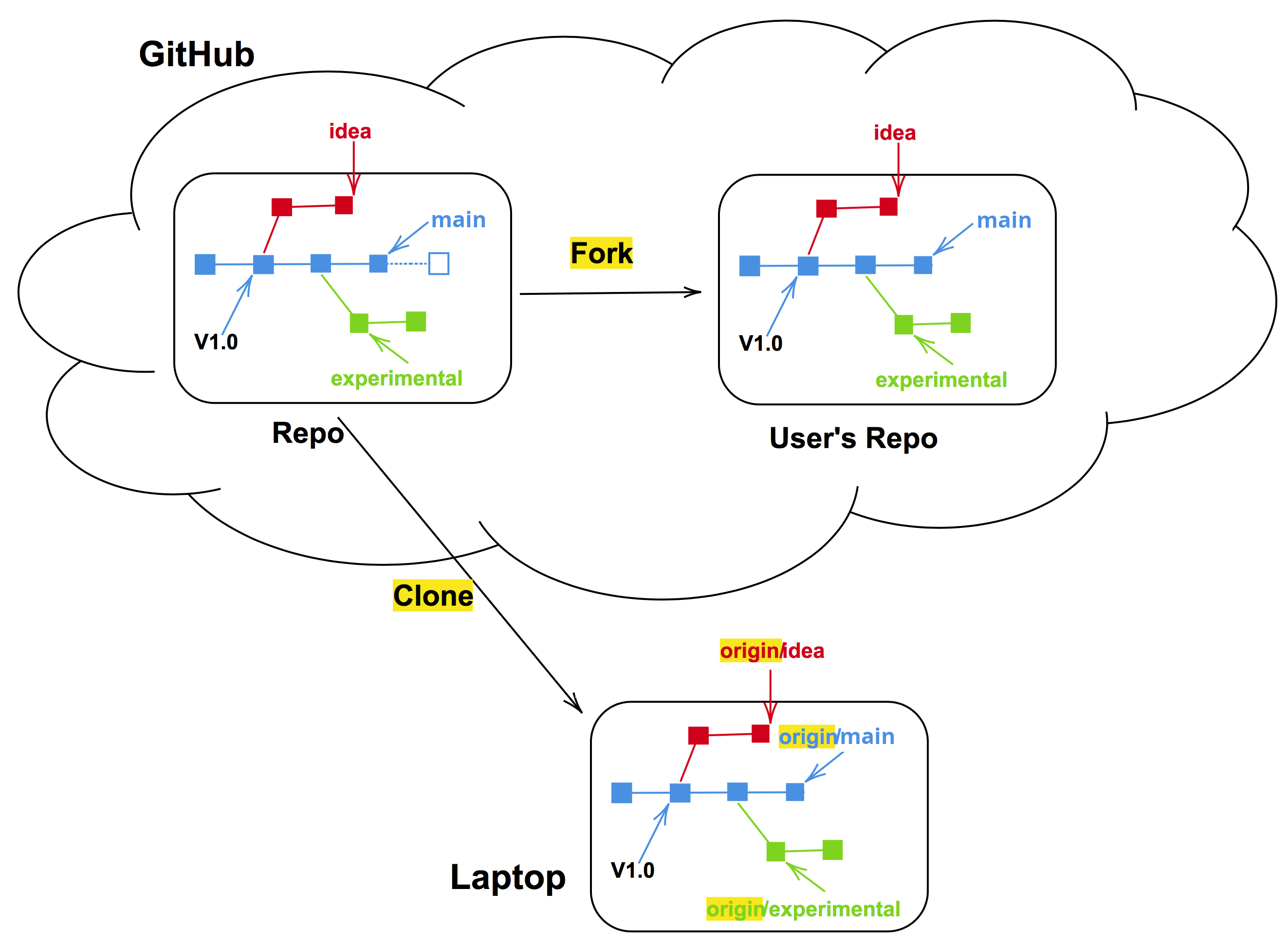Concepts around collaboration
Objectives
Be able to decide whether to divide work at the branch level or at the repository level.
Commits, branches, repositories, forks, clones
repository: The project, contains all data and history (commits, branches, tags).
commit: Snapshot of the project, gets a unique identifier (e.g.
c7f0e8bfc718be04525847fc7ac237f470add76e).branch: Independent development line. The main development line is often called
main. Technically, a branch in Git is implemented as a pointer to a commit (imagine a sticky note with a branch name on it).tag: A pointer to one commit, to be able to refer to it later. Like a commemorative plaque that you attach to a particular commit (e.g.
phd-printedorpaper-submitted).cloning: Copying the whole repository to your laptop - the first time. It is not necessary to download each file one by one.
forking: Taking a copy of a repository (which is typically not yours) - your copy (fork) stays on GitHub/GitLab and you can make changes to your copy.
Cloning a repository
In order to make a complete copy a whole repository, the git clone command
can be used. When cloning, all the files, of all or selected branches, of a
repository are copied in one operation. Cloning of a repository is of relevance
in a few different situations:
Working on your own, cloning is the operation that you can use to create multiple instances of a repository on, for instance, a personal computer, a server, and a supercomputer.
The parent repository could be a repository that you or your colleague own. A common use case for cloning is when working together within a smaller team where everyone has read and write access to the same Git repository.
Alternatively, cloning can be made from a public repository of a code that you would like to use. Perhaps you have no intention to change the code, but would like to stay in tune with the latest developments, also in-between releases of new versions of the code.

Forking and cloning
Forking a repository
When a fork is made on GitHub/GitLab a complete copy, of all or selected branches, of the repository is made. The copy will reside under a different account on GitHub/GitLab. Forking of a repository is of high relevance when working with a Git repository to which you do not have write access.
In the fork repository commits can be made to the default branch (
mainormaster), and to other branches.The commits that are made within the branches of the fork repository can be contributed back to the parent repository by means of pull or merge requests.
Synchronizing changes between repositories
Repositories that are forked or cloned do not automatically synchronize themselves.
We need a mechanism to communicate changes between the repositories.
We will pull or fetch updates from remote repositories (we will soon discuss the difference between pull and fetch).
We will push updates to remote repositories.
We will learn how to suggest changes within repositories on GitHub and across repositories (pull requests).
A main difference between cloning a repository and forking a repository is that the former is a general operation for generating copies of a repository to different computers, whereas forking is a particular operation implemented on GitHub/GitLab.
Should we clone or fork?
Should we all work inside one repository and clone? Or should we all work on forks?
For most small or medium-sized research projects you probably want to work by cloning a repository that all research group has write access to (we will exercise this in the next section).
It’s only when you want to contribute to a project that you don’t have write access to that you need to use forks (we will practice this as well).
Generating from templates
A repository can be marked as template and new repositories can be generated from it, like using a cookie-cutter.
The newly created repository will start with a new (“flattened”) history, only one commit, and not inherit the history of the template.

Generating from a template.